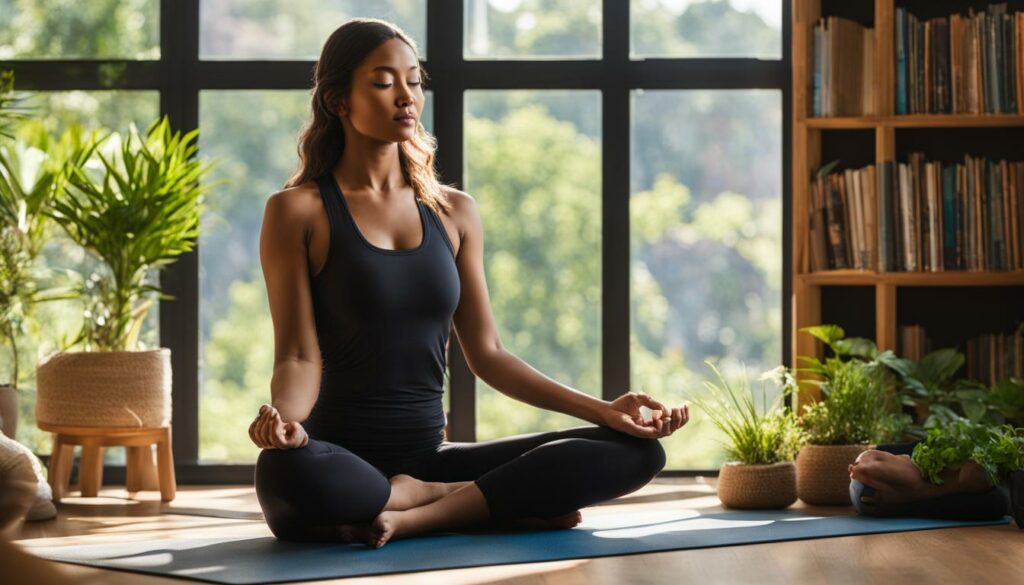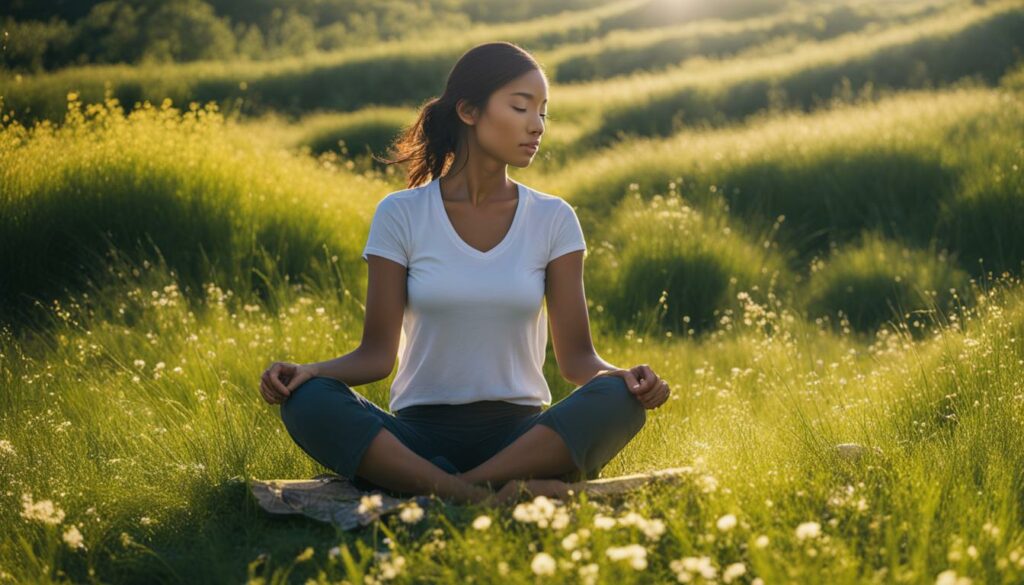Welcome to our guide on mindfulness! In today’s fast-paced world, it’s easy to get caught up in the hustle and bustle of everyday life, leaving us feeling stressed, overwhelmed, and disconnected. But what if there was a way to bring more calm, clarity, and presence into our lives? That’s where mindfulness comes in.
Mindfulness is the practice of being fully present in the current moment, without judgment or distraction. It’s about cultivating awareness, paying attention to our thoughts, feelings, and surroundings, and embracing a state of non-reactivity. By incorporating mindfulness into our daily routine, we can experience a range of benefits that can improve our overall well-being and quality of life.
But you may be wondering, how can I practice mindfulness? We’re here to show you just how simple it can be. In this guide, we’ll explore various mindfulness practices, techniques, and exercises that you can incorporate into your daily life. From mindfulness meditation and breathing exercises to mindful movement and journaling, there’s something for everyone.
Key Takeaways:
- Mindfulness is the practice of being fully present in the current moment, without judgment or distraction.
- By incorporating mindfulness into our daily routine, we can experience a range of benefits, including stress reduction and improved focus.
- There are various mindfulness practices and techniques, such as meditation, breathing exercises, and mindful movement, that we can incorporate into our daily lives.
- Start small and be consistent in your mindfulness practice to make it a habit.
- Mindfulness can bring a sense of peace, clarity, and joy to our daily lives.
What is Mindfulness and Why is it Important?
Mindfulness is a practice that involves observing and accepting the present moment without trying to change it. It requires us to be fully present and aware of our thoughts, feelings, and surroundings. By cultivating mindfulness, we can develop greater self-awareness and make conscious choices in our daily lives.
But why is mindfulness important? The answer lies in the numerous benefits it offers. Research has shown that mindfulness practice can help reduce stress and anxiety, improve focus and attention, promote emotional well-being, and enhance overall mental health. It allows us to become more attuned to our inner selves and to the world around us, fostering a sense of peace, clarity, and connection.
Incorporating mindfulness activities and techniques into our daily routine is key to experiencing these benefits and living a more mindful and fulfilling life. Whether you’re a beginner or have been practicing mindfulness for a while, there are various techniques that can help you start or deepen your mindfulness practice.
“Mindfulness is the awareness that arises from paying attention, on purpose, in the present moment, non-judgmentally.” – Jon Kabat-Zinn
Mindfulness Activities
Here are some mindfulness activities you can incorporate into your daily routine:
- Mindful breathing exercises
- Body scan meditation
- Walking meditation
- Mindful eating
- Journaling
- Gratitude practice
These activities can help you cultivate mindfulness and bring your attention to the present moment. They encourage you to engage your senses, observe your thoughts and feelings without judgment, and foster a deeper connection with yourself and your environment.
Mindfulness Techniques for Beginners
If you’re new to mindfulness, here are some techniques that are perfect for beginners:
- Body scan meditation: Start by lying down or sitting comfortably. Slowly scan your body from head to toe, bringing attention to each body part and noticing any sensations or tension.
- Mindful breathing: Focus on your breath as it enters and leaves your body. Pay attention to the sensation of your breath, the rise and fall of your abdomen, and the feeling of air passing through your nostrils.
- 5-4-3-2-1 grounding technique: Engage your senses by naming five things you can see, four things you can touch, three things you can hear, two things you can smell, and one thing you can taste.
Remember, mindfulness is a practice, and it takes time and consistency to develop. Start with just a few minutes each day and gradually increase the duration of your practice as you feel comfortable.

By incorporating mindfulness into your daily life, you can experience the powerful benefits it has to offer. From reducing stress and anxiety to improving focus and emotional well-being, mindfulness can transform your daily experiences and help you live a more present and fulfilling life.
How to Incorporate Mindfulness into Your Daily Routine
Incorporating mindfulness into our daily routine doesn’t have to be complicated or time-consuming. It can be as simple as taking a few moments each day to practice mindfulness exercises and techniques.
- Mindfulness meditation: Set aside a specific time each day to sit quietly and focus on your breath or a chosen point of focus. Allow thoughts to come and go without judgment, simply observing them.
- Mindful breathing: Take a few intentional deep breaths throughout the day, focusing your attention on the sensation of the breath entering and leaving your body. Use this as an anchor to bring your awareness back to the present moment.
- Visualization: Engage in visualizing a peaceful and serene place, using your imagination to create a mental image of a calming environment. Allow yourself to fully immerse in the sensory details and experience a sense of tranquility.
- Mindful movement: Incorporate mindful movement practices such as yoga or tai chi into your daily routine. Pay attention to the sensations in your body, the rhythm of your breath, and the present moment as you move and flow.
- Journaling: Dedicate a few minutes each day to journaling your thoughts, emotions, and experiences. This practice can help increase self-awareness and reflection, promoting mindfulness in your daily life.
By setting aside dedicated time each day for these practices, we can create a habit of mindfulness and make it a regular part of our daily routine. Even just a few moments of mindfulness each day can have a significant impact on our overall well-being and help us stay grounded and present in the midst of our busy lives.

The Benefits of Daily Mindfulness Practice
“The present moment is the only time over which we have dominion.” – Thich Nhat Hanh
Engaging in a daily mindfulness practice has numerous benefits for our mental, emotional, and physical well-being. Here are some of the key benefits:
| Benefits of Daily Mindfulness Practice |
|---|
| Reduces stress and anxiety |
| Improves focus and attention |
| Promotes emotional well-being |
| Enhances self-awareness |
| Fosters compassion and empathy |
| Increases resilience |
| Improves sleep quality |
These are just a few examples of the transformative effects that daily mindfulness practice can have on our lives. By incorporating mindfulness into our daily routine, we can cultivate a greater sense of peace, happiness, and well-being.
How to Make Mindfulness a Habit
Making mindfulness a habit requires consistency and intention. It’s important to develop mindfulness as a regular practice in our daily lives, so that it becomes a natural part of who we are. By cultivating mindfulness as a habit, we can experience its transformative effects on our mental and emotional well-being.
To begin, set clear intentions for why you want to incorporate mindfulness into your life and what you hope to achieve from it. This will help you stay focused and motivated on your mindfulness journey. Start small by dedicating just a few minutes each day to practicing mindfulness. This could involve simple activities such as mindful breathing, body scan meditation, or mindful eating.
As you become more comfortable, gradually increase the duration of your mindfulness practices. Set aside a consistent time in your day for these practices, whether it’s in the morning, during a lunch break, or in the evening before bed. By establishing a routine, you create a structured space for mindfulness in your daily life.
It can also be helpful to set reminders or cues to help you remember to practice mindfulness. This might involve placing sticky notes with mindfulness prompts around your work area or setting alarms on your phone. These reminders serve as gentle nudges to bring you back to the present moment.
Don’t forget to celebrate even the small wins on your mindfulness journey. Acknowledge and appreciate each moment of mindfulness that you cultivate. Over time, these moments will add up and become an integral part of your daily life.
Remember, mindfulness is a journey, not a destination. Be patient with yourself and embrace the experience with curiosity and compassion. Every moment of mindfulness counts, no matter how small. With consistent practice, it becomes easier to stay present and practice mindfulness in every aspect of your life.

Developing mindfulness as a habit is a powerful way to find peace and clarity amidst the demands of daily life. By incorporating simple mindfulness practices into your routine, you can enjoy the many benefits it offers. Stay committed, be present, and watch as mindfulness transforms your life.
Conclusion
Mindfulness practice is a powerful tool that can significantly impact our daily lives and overall well-being. By incorporating mindfulness techniques into our daily routine, we can cultivate mindfulness as a habit and experience its numerous benefits. From reducing stress and anxiety to improving focus and emotional well-being, practicing mindfulness enables us to live a more present, connected, and fulfilling life.
When starting with mindfulness, it is important to begin with small steps and be consistent in our practice. By committing to a daily mindfulness practice, even for a few minutes, we can gradually develop the habit and make mindfulness an integral part of our day. It may take time and patience, but with consistent effort, mindfulness becomes a natural state of being.
Practicing mindfulness daily allows us to be fully present in the moment, fostering a sense of peace, clarity, and joy in our lives. By being mindful, we can navigate life’s challenges with greater resilience and find contentment in the simple joys surrounding us. So let us take the first step towards mindful living today and experience its transformative power in our own lives.
How Does Mindfulness Differ from Meditation in Daily Life?
Mindfulness and meditation are often used interchangeably, but they differ in practice. Mindfulness focuses on staying present, while meditation involves various meditation types for wellbeing, such as mindfulness, focused attention, and loving-kindness. Both can be incorporated into daily life to reduce stress and promote overall well-being.
Source Links
- https://www.mindful.org/take-a-mindful-moment-5-simple-practices-for-daily-life/
- https://www.calm.com/blog/5-simple-ways-to-practice-mindfulness-in-daily-life
- https://moniquetallon.com/10-simple-ways-to-practice-mindfulness-in-our-daily-life/

